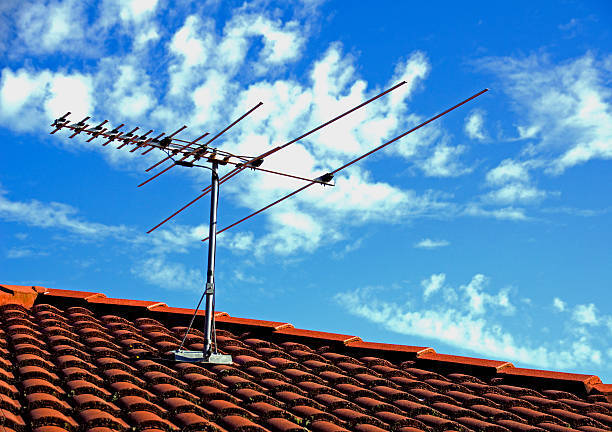Antennas are vital in TV setups, serving as the link between broadcast signals and television receivers. They capture electromagnetic waves, converting them into audiovisual content.
Antennas enable access to free, over-the-air channels, reducing dependence on cable or satellite services, promoting affordability, and ensuring widespread access to information and entertainment.
Indoor and outdoor antennas are gaining popularity as they offer enhanced TV reception, access to more channels, and improved signal quality. Cord-cutters and those seeking cost-effective alternatives appreciate antennas for free over-the-air broadcasts, contributing to a resurgence in antenna use for a diverse and affordable home entertainment experience.
This blog aims to guide readers in selecting the most suitable antenna for their needs by exploring the advantages and disadvantages of indoor and outdoor antennas, facilitating informed decision-making.
Understanding Indoor Antennas
Indoor antennas play a crucial role in enhancing television reception without the need for external installations. Three common types of indoor antennas are flat antennas, rabbit ears, and amplified antennas.
1. Flat Antennas
Flat antennas, also known as paper-thin antennas, are lightweight and discreet. They are designed to be placed on or near a window, providing an unobtrusive solution for urban dwellers or those in apartments. Despite their slim profile, flat antennas can effectively capture signals, making them suitable for digital TV.
2. Rabbit Ears
Rabbit ears, reminiscent of traditional antennas, consist of extendable rods resembling, well, rabbit ears. Rabbit ears are versatile and can pick up VHF and UHF signals, making them a reliable choice for a variety of channels.
3. Amplified Antennas
Amplified antennas incorporate signal amplifiers to boost weak signals, enhancing reception in areas with poor signal strength. These antennas are particularly useful in regions far from broadcast towers or in locations with interference. The built-in amplifier strengthens the incoming signal, reducing potential disruptions and providing clearer audio and video quality.
Pros Of Indoor Antennas
- Cost-Effective: Indoor antennas are a budget-friendly option for accessing free over-the-air (OTA) channels without subscription fees.
- Ease of Installation: They are easy to install, requiring minimal setup compared to outdoor antennas, making them ideal for urban or rental living.
- Compact Size: Indoor antennas are typically compact, making them suitable for small living spaces where larger outdoor antennas may not be practical.
- No Maintenance: They don’t require as much maintenance as outdoor antennas since they are shielded from the elements, reducing the need for adjustments.
- Versatility: Indoor antennas can be easily moved or repositioned to find the best signal, offering flexibility in optimising reception quality.
- Discreet Design: They have a low-profile design that blends well with indoor aesthetics, avoiding the visual impact associated with outdoor installations.
- Suitable for Urban Areas: In densely populated urban areas with signal interference, indoor antennas may provide a more reliable signal by avoiding external obstacles.
- No External Exposure: Being indoors protects them from weather-related wear and tear, ensuring consistent performance over time.
- HD Reception: Many indoor antennas support high-definition (HD) reception, delivering clear and crisp picture quality for TV broadcasts.

Cons Of Indoor Antennas
- Limited Range: Indoor antennas typically have a shorter range than outdoor ones, resulting in weaker signals and potential reception issues.
- Interference: Signal reception can be disrupted by indoor obstacles such as walls and electronic devices, leading to poor picture and sound quality.
- Weather Sensitivity: Indoor antennas are more susceptible to weather conditions, affecting signal strength during storms or adverse weather.
- Limited Channels: In certain locations, indoor antennas may struggle to capture all available channels, limiting the variety of programming.
- Setup Challenges: Achieving optimal positioning for indoor antennas can be challenging, requiring adjustments to minimise interference and enhance signal reception.
Exploring Outdoor Antennas
Outdoor antennas play a crucial role in enhancing signal reception for various applications, from television broadcasting to wireless communication. Three prominent types of outdoor antennas are Yagi antennas, log-periodic antennas, and parabolic antennas.
1. Yagi Antennas
Yagi antennas are known for their directional properties. Yagi antennas are popular for point-to-point communication and are commonly used for TV reception in areas with weak signals.
2. Log-Periodic Antennas
Log-periodic antennas offer a broad frequency range, making them versatile for receiving signals across multiple channels. Log-periodic antennas are preferred for television and radio reception, providing a reliable solution for users seeking a single antenna to capture diverse frequencies.
3. Parabolic Antennas
Parabolic antennas, recognized by their dish-like shape, are highly directional and excel at capturing signals from a specific point in space. Widely used in satellite communication and long-distance wireless networks, parabolic antennas focus signals on a central point, maximising reception efficiency.

Pros of Outdoor Antennas
- Enhanced Reception: Outdoor antennas typically provide superior signal reception compared to indoor alternatives.
- Extended Range: They can capture signals from a broader geographical area, ensuring access to more channels.
- Reduced Interference: Being outside reduces the chances of interference from walls and obstacles, resulting in clearer signals.
- Better Signal Quality: Outdoor antennas often deliver better picture and sound quality for television and radio broadcasts.
- Durable and Weather-Resistant: Designed to withstand various weather conditions, outdoor antennas are more durable and less prone to wear and tear.
- Multi-Directional Options: Some outdoor antennas can be adjusted to capture signals from multiple directions, optimising reception.
- Ideal for Rural Areas: In remote locations, outdoor antennas offer improved connectivity, reaching signals from distant broadcasting towers.
Cons of Outdoor Antennas
- Weather Dependence: Outdoor antennas are vulnerable to weather conditions, impacting signal quality during storms, heavy rain, or snow.
- Installation Challenges: Mounting an outdoor antenna requires expertise and can be challenging for individuals without technical skills. It often involves climbing heights and dealing with complex setups.
- Aesthetics: Outdoor antennas can be visually unappealing, affecting the aesthetics of your property. Homeowners’ associations may have restrictions on their use.
- Limited Mobility: Once installed, outdoor antennas are fixed, limiting flexibility in adjusting signal direction. This can be problematic if signal sources change or if you move to a new location.
- Maintenance: Outdoor antennas demand periodic maintenance, including cleaning and potential repairs, adding to the overall hassle and cost.
Factors Influencing Your Decision
1. Signal Strength and Quality
One crucial factor when deciding between outdoor and indoor antennas is the signal strength and quality in your area. If you live in an urban environment with a clear line of sight to broadcast towers, an indoor antenna may suffice.
However, for those in rural or obstructed areas, an outdoor antenna’s higher elevation and unobstructed view can significantly improve reception.
2. Geographic Location
Consider your geographic location and the terrain surrounding your home. Urban areas with numerous buildings might introduce interference for indoor antennas, while rural locations with fewer obstructions often benefit from the broader reach of outdoor antennas.
3. Regulatory Restrictions
Check local regulations and rules regarding antenna installations. Some areas have restrictions on outdoor antennas due to aesthetic concerns or zoning regulations. In such cases, you might need to explore advanced indoor antenna options that can still provide satisfactory signal strength.
4. Maintenance and Durability
Consider the maintenance and durability of the antenna. Outdoor antennas are exposed to the elements, so they need to be weather-resistant and durable. Indoor antennas, being shielded from harsh weather conditions, may require less maintenance.
Budget Considerations
Cost comparison between indoor and outdoor antennas
- Indoor antennas generally have a lower upfront cost compared to outdoor antennas. They are designed for simplicity and ease of installation.
- Outdoor antennas typically have a higher initial cost compared to indoor antennas. This is due to their design for better signal reception over longer distances.
Additional expenses to factor in-
- Cables: Both indoor and outdoor antennas require coaxial cables to connect the antenna to the TV. The length and quality of the cable can impact the cost. It’s important to choose a cable that minimises signal loss.
- Mounting Hardware: Outdoor antennas often require mounting hardware such as brackets, masts, and screws. The type of mounting hardware needed depends on the antenna’s design and the location where it will be installed.
- Signal Amplifiers: In some cases, signal amplifiers may be necessary, especially for outdoor antennas in areas with weak signals. Signal amplifiers come at an additional cost and should be selected based on the specific needs of the installation.
- Lightning Protectors: Outdoor antennas may need lightning protectors to safeguard against electrical surges during storms, requiring additional costs.
In short, while indoor antennas are generally more cost-effective initially, outdoor antennas offer superior range and performance, particularly in challenging signal environments.
The additional expenses for both types include cables, mounting hardware, signal amplifiers, lightning protectors, and potential professional installation costs.
Need Assistance?
Olympic Electrical in Sydney offers a solution for poor TV reception. Our experienced team of experts knows where to install the antenna by understanding the signals in your area.
We can improve your TV signal, whether it’s for home or business, by finding the best antenna for your needs. We handle the technicalities, allowing you to enjoy your favourite shows without interruption.
Schedule your TV antenna installation today for a smarter entertainment upgrade today, and contact us for more information!
